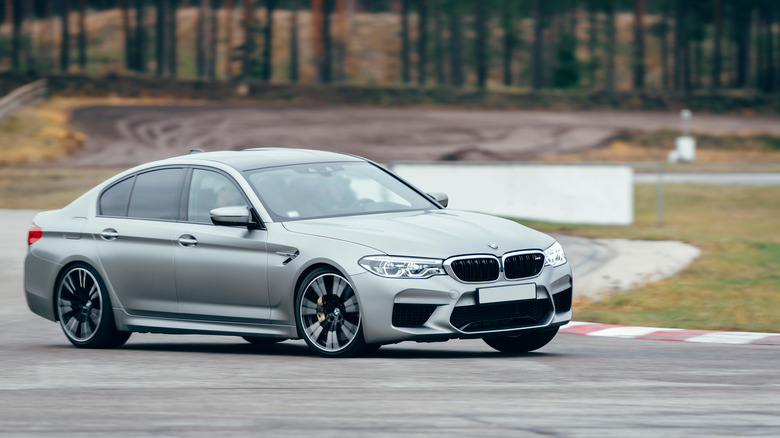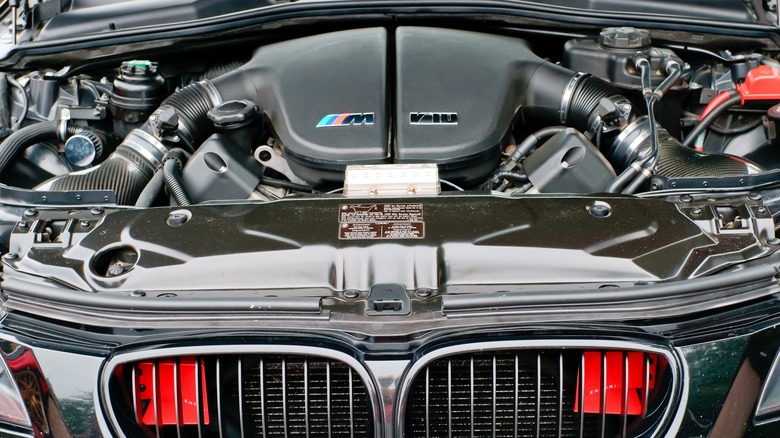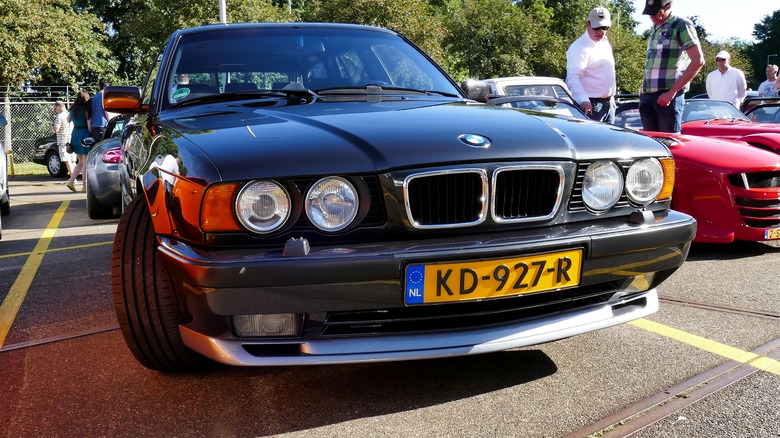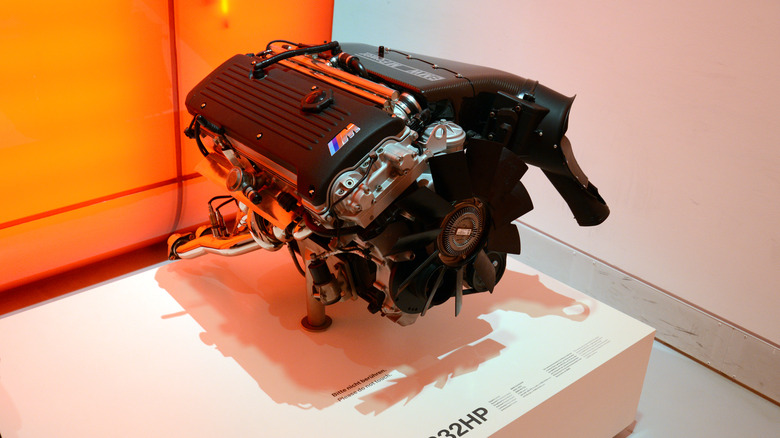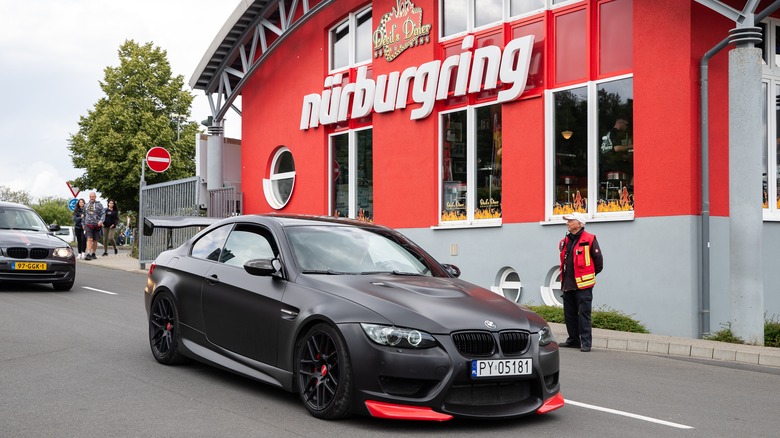What Makes BMW M Series Engines So Good
BMW has a well-earned reputation for building high-quality cars that perform well in most circumstances. The Munich-based automaker also has a high-performance line of vehicles, which can serve as a daily driver while also tearing it up on the track. The creatively named "M" (for Motorsport) series of vehicles debuted in the 1980s, and has evolved from an extremely rare supercar to an obscenely powerful sedan. However, each incarnation has had one thing in common: a purpose-built engine designed to provide all of the grunt.
Here, we'll explore some of the things that make M engines so special, from the manufacturing processes, to their components, to the well of emotions they inspire amongst BMW's fanbase. We'll also touch on some of this storied line of vehicles' history, and highlight how you, the consumer, weren't really meant to have one in the first place. Here's what sets the engines in an M apart from other BMWs, and everyone else.
They weren't really meant for the road
One of the things that sets BMW's M Series engines apart is the fact that they weren't initially designed with the road in mind. The original M1 is closer to a full-blown supercar than the suped-up coupes and sedans that came after — and it was built with a single purpose in mind. The Bavarian manufacturer wanted to dominate Group 5 racing, which in the late 1970s meant overcoming Porsche. The company collaborated with Italian supercar manufacturer Lamborghini to produce what is now one of the rarest and most desirable Bimmers of all time.
As Group 5 racing is centered on production cars, any cars that are competing have to be mass-produced and sold. BMW needed to knock up more than 400 M1s to qualify, so a run of 460 vehicles was approved. All of the cars were handmade, and BMW didn't put that much effort into selling them. Their existence was more of a technicality than anything, but that didn't stop the company's customer base from scrambling for their slice of the legendary automaker's Motorsport division. Despite being around double the price of a Ferrari 308, BMW's first and only supercar sold out pretty quickly and the concept took off from there.
However, the story doesn't end there. More than 460 of the M1's M88 engines were assembled, and later wound up in the M635i. The success of the M1 also paved the way for M vehicles on the whole. The concept of jamming a track-worthy engine (and some other parts) into a production vehicle was validated, and the company rolled on from there.
They sometimes involve exclusive designs
There's a certain exclusivity about an M engine. You'll only find them in M cars for a start, so that's the likes of the M2, M3, M5, and so on. It also means that getting the M package on a 3, 5, or 7 series may include a tune-up, some stripy seatbelts, and a few more advanced parts but it doesn't include one of the company's fabled M engines.
The exclusivity doesn't end there, however. Although the line is known for its naturally aspirated straight sixes, some M engines have unique configurations that you won't find in any other BMW, or even in the car's class in some cases. The S85 V10 is a good example. It's the only V10 you'll find in a BMW, and it's also the only V10 you'll see in a production saloon car. If you want to get your hands on one, you'll have to buy an E60/61 M5 or E63/64 M6. The S85 was also built from the ground up purely for M series cars. It doesn't use a standard BMW engine as a base like some of its brethren. The S65 is the V8 derivative of an S85 engine, once again exclusive to M vehicles. This award-winning engine is something you'll only find in an E90 or E92 M3, again demonstrating how exclusive some of these purpose-built engines are. An exception to the rule is the S14, which ended up in a 3 Series at one point, but many purists see the S14 as more of a spinoff than a true M engine.
Older variants have individual throttle bodies
In terms of performance, turbochargers have a bit of an advantage over naturally aspirated engines when it comes to performance. This is because it can force large amounts of air into the engine, allowing it to burn more fuel with each stroke. Naturally aspirated engines can still have a trick up their sleeves, and that comes in the form of individual throttle bodies.
Usually, a vehicle's engine comes with a single throttle body which controls the flow of air into the engine. This configuration is cheap and easy to maintain, but the intake manifold will be running a partial vacuum until that throttle is opened. Air at atmospheric pressure then has to travel through the manifold before hitting the cylinders. With individual throttle bodies, each cylinder has its own throttle body, the intake manifold can be full of air at atmospheric pressure, and that air doesn't have to travel far to hit the cylinders. A vacuum is instead pulled in the small space between the throttle bodies and the cylinders themselves.
As a result, the throttle is much more responsive, and the added efficiency generates more power for the engine. It also sounds fantastic, which adds to the driving experience these engines provide. There's plenty of talk about power and torque, but the driving experience itself involves noise, smells, and a general feeling of excitement.
You don't see this configuration often, because it's expensive to implement and harder to maintain. But older, naturally aspirated, M engines aimed to be as good as they could be. So many of them came with individual throttle bodies.
They tend to be bigger
While modern M engines will have a large turbocharger or two strapped to them, that isn't what many people picture when they think of the line at its best. For a long time, BMW's Motorsport division's best was built around the naturally aspirated straight six. This is partially due to some touring car rules, that banned turbochargers for a long time. Remember, selling Ms is an afterthought, the vehicles exist to win championships first and foremost.
There are a few ways to make a naturally aspirated engine more powerful. First, you can make it more efficient, so it gets more out of its fuel. Lax engineering is part of the reason classic American cars get surprisingly little horsepower out of a relatively huge engine. Japanese and European cars of the time could usually get about the same amount of grunt from something half the size of what you'd find at the front of a Mustang.
However, to put it bluntly, German engineering is quite good, and any gains in efficiency between generations will be somewhat limited as a result. To make an efficient engine more powerful, you need to make it bigger. It doesn't take a genius to work out that a bigger engine means more air and fuel can be burned in its cylinders and more power is produced as a result. This is the route M engines took for a long time, and they featured notably increased displacement when compared to the motors in BMW's standard vehicles.
They're all tested and tuned at the Nürburgring
Monza, Spa, Silverstone, there are many legendary racetracks throughout Europe. But none quite have the same reputation as the Nürburgring. The 14.2-mile loop of tarmac is located in the Rhineland, and has hosted some iconic touring car, F1, and endurance races over the years. It was also the scene of one of the most horrific accidents in motorsport history. Niki Lauda's 1976 crash left the Ferrari driver badly burned and fighting for his life. Crashes like that have helped shape the track's fearsome reputation, but legends aside, it is known to be one of the most technically difficult tracks to race on in the world. Aside from being the longest track on the planet, a combination of speed, elevation changes, and 154 corners means it can push any car and driver combo to its limits.
It may be reassuring to know that every M vehicle has to prove itself repeatedly on this track before it goes into production. If it can handle over 14 miles of obscenely difficult track it's likely to do pretty well on that two-mile stretch of windy country road near your house. Technically, all BMWs have to prove their worth at the Nürburgring, but knowing a vehicle can handle itself on one of the world's most demanding tracks is a major selling point.
They come with forged internals
High-end engines are often singled out by features like forged internals, so of course the engines in BMW's M series of vehicles have them. Engines contain many components, such as the connecting rods, pistons, crankshaft, and camshafts. On regular engines, these parts are usually cast as casting them is a cheaper and easier process. Just pour liquid metal into a mold before tidying up the results.
Forging involves heating metal until soft and then forcing it into a die. This is more expensive and a little bit specialist, but it has several benefits. Forged parts are stronger, so can withstand greater forces. This means the engines they are used in can run harder without breaking something. The increased strength also means components can be made slimmer, and subsequently lighter, than cast parts. Finally, forged parts hold their integrity at higher temperatures, which again means the engine can run harder, for longer, without suffering a catastrophic failure. There's a reason that regular family sedans redline at around 5,000 RPM, while high-end performance cars like BMW's Ms can comfortably maintain that on a track all day without any issues.
You get bragging rights
There are plenty of things petrolheads love about BMW's M engines, and that's more than enough for a true purist to consider investing in an M vehicle. But that's not the only factor to consider. There's also a lot of prestige that comes with the products of BMW's motorsport division. Sure, paying an extra five figures for an "M" package on one of the company's 3, 5, or 7 series sedans gets you a performance boost, a bit of heightened throttle response, and some exclusive styling. However, it will not compare to a true M vehicle with a proper M engine.
Said bragging won't all be hot air either; Stick a detractor in the passenger seat, find a nice clear stretch of road, and put your foot down (right up until the needle hits the posted speed limit), and they'll understand what it's all about. While they may just look like a collection of sports coupes and sedans, BMW's M models are something special. Yes, effort goes into the suspension, brakes, transmission, driving aids, and everything else — but if you take away the engine and drop something normal in, it just wouldn't be the same.
They're a piece of history
BMW has not made its electric aspirations a secret in any way. The company aims to shift half of its production to electric vehicles by 2025, and it's also looking into other alternative fuel systems like hydrogen. Although M vehicles are likely to be the last to go, we're still going to see an electric M hit the market in the next few years. Testing on a prototype began in 2022, and M packages are already springing up on its electrified sedans. If the M series goes all-electric, that will be the end of the road for new M engines.
However, the enthusiasm is unlikely to die. Just as some die-hards swear by a naturally aspirated inline-six, and subsequently get their hands on their dream car via the second-hand market, M lovers who insist on an ICE will also emerge. So as the world moves away from oil, rest assured that some of these magnificent engines will still survive and be lovingly maintained by the people who appreciate them the most.
